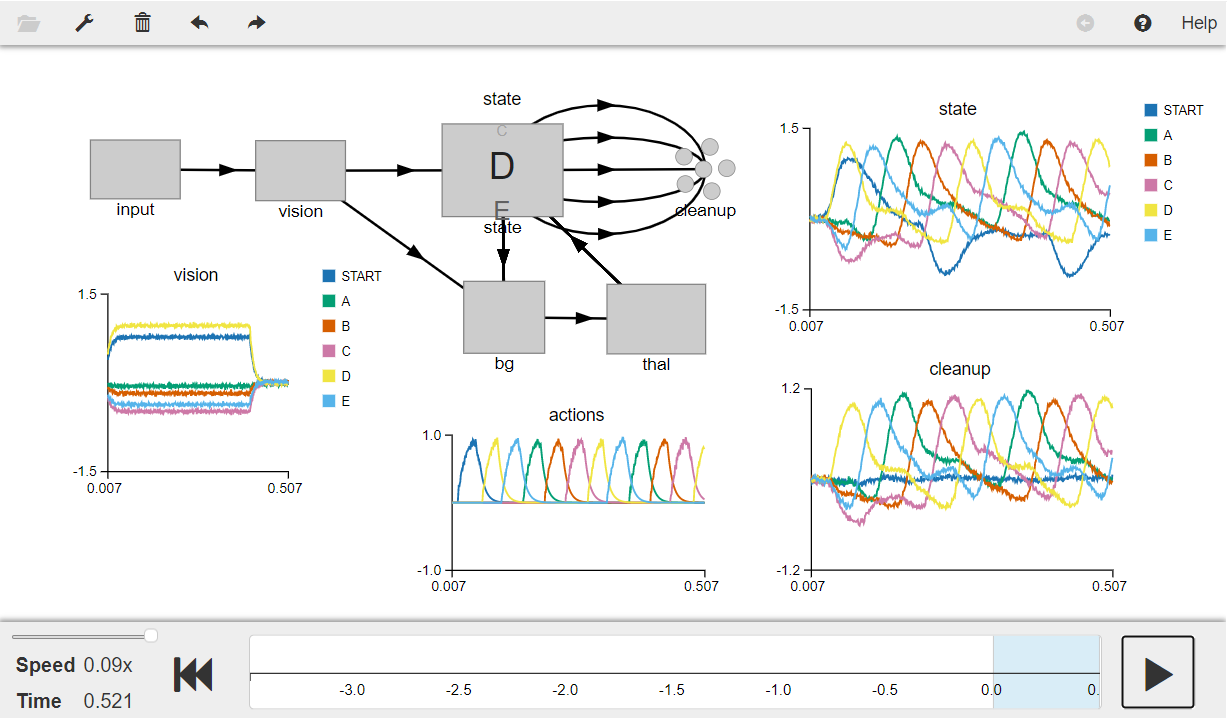- NengoLoihi
- How to Build a Brain
- Tutorials
- A Single Neuron Model
- Representing a scalar
- Representing a Vector
- Addition
- Arbitrary Linear Transformation
- Nonlinear Transformations
- Structured Representations
- Question Answering
- Question Answering with Control
- Question Answering with Memory
- Learning a communication channel
- Sequencing
- Routed Sequencing
- Routed Sequencing with Cleanup Memory
- Routed Sequencing with Cleanup all Memory
- 2D Decision Integrator
- Requirements
- License
- Tutorials
- NengoCore
- Ablating neurons
- Deep learning
Routed Sequencing with Cleanup all Memory¶
The previous model on “Routed Sequencing with Cleanup Memory” used a scalar ensemble to project only state A. In this model, you will project all the states onto an ensemble of neurons as the state cycles through a five element sequence.
[1]:
# Setup the environment
import numpy as np
import nengo
from nengo import spa # import spa related packages
from nengo.spa import Vocabulary
Create the model¶
This model has parameters as described in the book. It extends the routed sequencing model by creating a scalar ensemble cleanup and then projecting all the states on to this ensemble using a transformation matrix pd, specified by the vectors in the vocabulary.
[2]:
# Number of dimensions for the Semantic Pointers
dim = 16
# Change the seed of this RNG to change the vocabulary
rng = np.random.RandomState(4)
vocab = Vocabulary(dimensions=dim, rng=rng, max_similarity=0.1)
# Make a model object with the SPA network
model = spa.SPA(label="Routed_Sequence with cleanupAll", vocabs=[vocab])
with model:
# Specify the modules to be used
model.state = spa.State(dimensions=dim, feedback=1, feedback_synapse=0.01)
model.vision = spa.State(dimensions=dim)
# Specify the action mapping
actions = spa.Actions(
"dot(vision, START) --> state = vision",
"dot(state, A) --> state = B",
"dot(state, B) --> state = C",
"dot(state, C) --> state = D",
"dot(state, D) --> state = E",
"dot(state, E) --> state = A",
)
# Creating the BG and thalamus components that confirm to the specified rules
model.bg = spa.BasalGanglia(actions=actions)
model.thal = spa.Thalamus(model.bg)
# Get vocabulary items in order of creation
vsize = len((model.get_output_vocab("state").keys))
vocab_items = []
for index in range(vsize):
vocab_items.append(model.get_output_vocab("state").keys[index])
# Creating the transformation matrix (pd) and cleanup SPA State (cleanup)
pd = []
for item in vocab_items:
pd.append([model.get_output_vocab("state")[item].v.tolist()])
model.cleanup = nengo.Ensemble(n_neurons=300, dimensions=vsize)
# Function that provides the model with an initial input semantic pointer.
def start(t):
if t < 0.4:
return "0.8*START+D"
return "0"
# Input
model.input = spa.Input(vision=start)
# Projecting the state to the cleanup ensemble using a transformation matrix 'pd'.
# Note that the first item in the vocabulary (`START`) is ignored.
for i in range(1, vsize):
nengo.Connection(model.state.output, model.cleanup[i], transform=pd[i])
Run the model¶
[ ]:
# Import the nengo_gui visualizer to run and visualize the model.
from nengo_gui.ipython import IPythonViz
IPythonViz(model, "ch7-spa-sequence-routed-cleanup-all.py.cfg")
Press the play button in the visualizer to run the simulation. You should see the graphs as shown in the figure below.
The graph in the middle shows the semantic pointer representation of the values stored in state and the plot on the bottom-right shows the response of the cleanup population. and the graph on the top-right shows the utility (similarity) of the current Basal Ganglia input (i.e., state) with the possible vocabulary vectors.
Since the cleanup operation is similar to a dot product between the state and the defined vocabulary vectors, the value of the cleanup population in a particular dimension rises only when the value of state (top-right graph) corresponds to that particular dimension.
[3]:
from IPython.display import Image
Image(filename="ch7-spa-sequence-routed-cleanup-all.png")
[3]:
